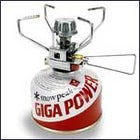Well, you leave out some critical information. Such as, did the stove work when you got back home? Because of course it could simply be broken. Or moisture could have gotten in there (although it would take a soaking to shut off a piezo lighter). Or something else that I’m unable to divine in my gear-voyant way.
 Snow Peak GigaPower
Snow Peak GigaPower
That said, it’s plausible that the altitude was high enough to cause the lighter failure. I don’t recall ever having used a piezo at 10,000 feet or above, so I can’t speak from personal experience. But some lighter manufacturers recommend using flint lighters rather than piezo-driven ones at high altitude, although that’s usually more in the 12,000 feet or higher range. Still, lack of oxygen is a somewhat plausible explanation for the stove’s failure to ignite.
Could it be something else? Sure. The Snow Peak folks (who make the GigaPower, which sells for $50 with the on-board igniter; www.snowpeak.com) say that it’s possible the stove was bumped in some fashion, so that the igniter isn’t quite aligned properly. It’s easy to fix with a pair of needle-nose pliers, but if the stove still isn’t working I’d take it back to your dealer to see if they can check the alignment of the igniter.
Beyond that, it’s always prudent to carry a back-up flame source, i.e. matches. I usually squirrel several batches of them throughout my pack, all waterproofed in some fashion. Piezo lighters are common, sturdy, and reliable, but they’re also mechanical (OK, electro-mechanical), and so can fail at inopportune times.
Check out �����ԹϺ���‘s for stove reviews, a guide to stove care, a user’s guide, and more.


